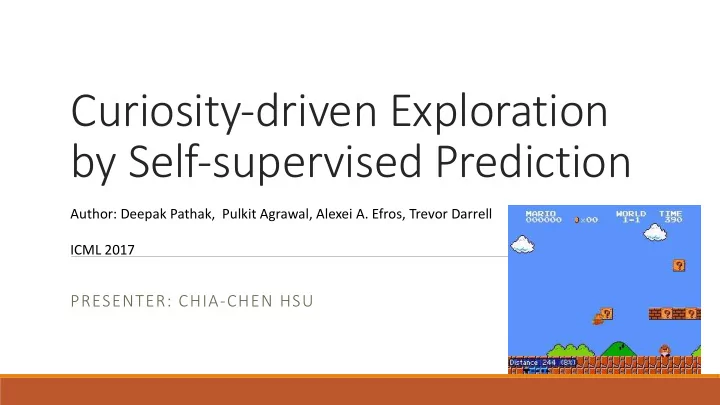

Curiosity-driven Exploration by Self-supervised Prediction Author: Deepak Pathak, Pulkit Agrawal, Alexei A. Efros, Trevor Darrell ICML 2017 PRESENTER: CHIA-CHEN HSU
Reinforcement Learning Credit: http://cs231n.stanford.edu/slides/2017/cs231n_2017_lecture14.pdf
Example – Alpha Go Objective: Win the game! State: Position of all pieces Action: Where to put the next piece down Reward: 1 if win at the end of the game, 0 otherwise Credit: http://cs231n.stanford.edu/slides/2017/cs231n_2017_lecture14.pdf
Example -- Games Objective: Complete the game with the highest score State: Raw pixel inputs of the game state Action: Game controls e.g. Left, Right, Up, Down Reward: Score increase/decrease at each time step Credit: http://cs231n.stanford.edu/slides/2017/cs231n_2017_lecture14.pdf
Reward--Motivation “Forces” that energize an organism to act and that direct its activity. Extrinsic Motivation: being moved to do something because of some external reward ($$, a prize, etc.). Intrinsic Motivation: being moved to do something because it is inherently enjoyable. ◦ Curiosity, Exploration, Manipulation, Play, Learning itself . . . ◦ Encourage the agent to explore “novel” states ◦ Encourage the agent to perform actions that reduce the error/uncertainty in the agent’s ability to predict the consequence of its own actions
Challenge of Intrinsic Motivated Imagine: movement of tree leaves in a breeze ◦ Pixel prediction would be high Observation ◦ (1) things that can be controlled by the agent; ◦ (2) things that the agent cannot control but that can affect the agent (e.g. a vehicle driven by another agent), ◦ (3) things out of the agent’s control and not affecting the agent (e.g. moving leaves). Goal : predict what change of states are caused by agent or will affect the agent
Self-supervised prediction Inverse (∅(𝑇 " ) , ∅(𝑇 "$% )) → 𝑏 " , 𝑇 " 𝑇 "$% Forward - f ∅(𝑇 " , 𝑏 " ) → ∅(𝑇 " ) ∅(𝑇 "$% ) ∅(𝑇 " ) Reward 𝑏 "
Architecture • A3C • Proposed by Google DeepMind. State-of-the-art RL architecture • 4 convolution + LSTM with 256 units + 2 fully connected • Two separate fully connected layers are used to predict ◦ The value function ◦ The action from the LSTM feature representation Forward • Intrinsic Curiosity Module (ICM) Architecture ∅(𝑇 " ) 𝑇 " ∅(𝑇 " ) 𝑏 " , - ∅(𝑇 "$% ) 𝑏 " 288 4 256 ∅(𝑇 "$% ) 256 Inverse 288 288
Experiment Environment 1. Super Mario Bros 2. VisDoom Setting 1. Sparse extrinsic reward on reaching a goal 2. Exploration without extrinsic reward
Sparse extrinsic reward on reaching a goal
Exploration VisDoom Mario 30% of level 1
De Demo ICLR2017[2] ICML 2017 NIPS2016[1] Winner, Visual Doom AI Competition2016 (This paper) 《 Deep Successor Reinforcement Learning 》 by MIT & Harvard. NIPS 2016 workshop 《 Learning to Act by Predicting the Future 》 by IntelLab. ICLR 2017 (oral)
Backup
Self-supervised prediction--Reward Two subsystems • A reward generator that outputs a curiosity-driven intrinsic reward signal • Rewards r t = r i t + r e t • A policy that outputs a sequence of actions to maximize that reward signal. In addition to intrinsic
Intrinsic Curiosity Module (ICM) Architecture The inverse model ◦ first maps the input state (st) into a feature vector φ(st) using a series of four convolution layers, each with 32 filters, kernel size 3x3, stride of 2 and padding of 1. ELU non-linearity ◦ The dimensionality of φ(st) is 288. ◦ For the inverse model, φ(st) and φ(st+1) are concatenated into a single feature vector and passed as inputs into a fully connected layer of 256 ◦ Fully connected layer with 4 units to predict one of the four possible actions. The forward model ◦ Concatenating φ(st) with at and passing it into a sequence of two fully connected layers with 256 and 288 units respectively.
Self-supervised prediction Forward Inverse Reward
Intrinsic Reward in RL 1. Explore “Novel” state 2. Reduce error/uncertainty
Fine tuned with curiosity vs external
http://realai.org/intrinsic-motivation/ http://swarma.blog.caixin.com/archives/164137 https://data- sci.info/2017/05/16/%E4%B8%8D%E9%9C%80%E8%A6%81%E5%A4%96%E9%83%A8reward%E7 %9A%84%E5%A2%9E%E5%BC%B7%E5%BC%8F%E5%AD%B8%E7%BF%92-curiosity-driven- exploration-self-supervised-prediction/ https://weiwenku.net/d/100573787 **
Recommend
More recommend